Abstract
Performing corporate social responsibility is the only way to adapt to sustainable economic and social development and is also the inevitable choice to enhance the core competitiveness of enterprises. At the beginning of 2020, the rapid spread of the COVID-19 epidemic made SMEs face a survival crisis. Therefore, SMEs need to continue to shoulder their social responsibilities in this special period. In view of this, this paper, with the COVID-19 outbreak as the background, constructed the evolution of the government regulatory agency, SME, and consumer evolutionary game model. This paper studies the strategy choice of three subjects in the process of fulfilling social responsibility before and after public health emergencies and analyzes the influence of dynamic incentive and punishment measures, cash, and inventory on the performance of SMEs’ social responsibility using MATLAB. The results show that the government regulatory agencies play a guiding role in the enterprise responsibility process and need to provide appropriate liquidity for SMEs; SMEs should actively participate in social responsibility activities, optimize internal governance, and prepare enough cash for a crisis; consumers need to develop responsible consumer market, expand the responsible consumption scale, and help SMEs share the difficulties.
MSC:
91A22
1. Introduction
In December 2019, The COVID-19 outbreak occurred around the world, seriously threatening human life and health. The World Health Organization (WHO) listed the COVID-19 outbreak in January 2020 as a “Public Health Emergency of International Concern” (PHEIC). The COVID-19 epidemic has impacted the global financial market and the entire macroeconomy and also has had varying degrees of effects on various industries. This impact has cross-industry and cross-regional characteristics and is accompanied by risk transmission and risk spillover effects [1]. In the face of the global influenza pandemic and sudden major social risks that seriously affect public health security, it is crucial for companies to actively fulfill their social responsibilities. However, companies still engage in irresponsible behaviors, such as fake vaccine incidents, pickled cabbage in soil pits, gutter oil incidents, and so on [2]. In order to obtain profits, enterprises carry out bad production and operation activities, which causes many consequences that they must bear [3].
As a major public health emergency, COVID-19 has the characteristics of “great damage, wide impact, and fast transmission.” The short-term impact on cash holdings has a greater impact [4]. However, the performance of corporate social responsibility can enhance the value of cash holding [5] and thus enhance the ability of enterprises to deal with emergencies. According to past experience, in the face of major emergencies, enterprises that can actively fulfill social responsibility can not only make them quickly get rid of the predicament but also be directly related to the development path of the enterprises in the future “post-epidemic era” [6]. Corporate social responsibility governance is an important way for enterprises to participate in social and public governance. The current concept of corporate social responsibility believes that the company’s active performance of corporate social responsibility can earn the company a social reputation and other intangible assets [7], which are important parts of enhancing the value of the company, are conducive to improving the company’s performance, and play a positive role in the company [8,9,10]. One way to maximize the use of the public social attribute is to connect it to responsibilities for the national economy, social development, and environmental protection, thereby helping economic and social management innovation, improving COVID-19 outbreak and other public health crisis response, preventing major social crises, and controlling management efficiency. Such social responsibility has become a major theoretical and practical topic that must be faced and deeply studied against the background of modernization of the national management system and management capacity [11].
China first clarified the concept of SMEs in 2003 in the Provisional Provisions on Standards for Small and Medium-sized Enterprises (SMEs). In 2011, the standards were adjusted accordingly. Notably, the latest standard is the Statistical Division Standard of Large, Small, Medium, and Micro Enterprises issued by the National Bureau of Statistics Quasi (2017). The standard divides enterprises into four types: large, medium, small, and micro, which are mainly divided according to the three indicators of enterprise revenue, employees, and total assets and slightly adjusted according to the differences and characteristics of different industries. In recent years, small, medium, and micro enterprises have contributed more than 50% of China’s tax revenue, 60% of GDP, more than 70% of technological innovation, 80% of urban employment, and more than 90% of enterprises. They are the main force in national economic and social development (The first meeting of the State Council Leading Group for promoting the Development of Micro, Small, and Medium-sized Enterprises). In this paper, an SME—short for a small and medium-sized enterprise—is the opposite of the concept of a large enterprise and mainly refers to a relatively weak enterprise according to assets, the number of employees, enterprise income, business scope, and influence. In this unprecedented global public health crisis, in order to prevent and control the sudden COVID-19 epidemic, people and logistics at home and abroad were strictly restricted, the economy was systematically stagnated, and the operation of micro, small, and medium-sized enterprises was hit hard, subjected to shock, and fell into a deep operational and financial crisis [12]. Under the impact of the epidemic, the financial vulnerability risks of micro, small, and medium-sized enterprises were more obvious, and those SMEs needed more financial support. However, it also became more difficult to obtain financial support. Social responsibility for SMEs during major public health emergencies is more complex than during a normal period. As small and medium-sized enterprises’ living environments saw huge changes when dealing with major public health emergencies, we should actively respond to the frontline needs of fighting the epidemic through different channels and in different ways. Such a response includes actively assuming social responsibility and coordinating with government regulatory agencies, workers, consumers, suppliers, and other relevant parties, to make important contributions to epidemic prevention and control, social stability, and development [13]. This reflects the responsibility of small and medium-sized enterprises. The research in the existing literature has achieved some results, but most of the works focus on an empirical analysis of the relationship between corporate social responsibility and various factors. Among them, Simpson et al. [14], Wen et al. [15], and Yang et al. [16] studied the relationship between corporate social responsibility and financial performance. Simpson et al. reviewed it mainly from a banking perspective, Wen et al. analyzed the panel data mainly based on the perspective of stakeholders, and Yang et al. mainly conducted a comparative analysis of large, small, and medium-sized listed companies. Wang et al. [2], Li Zheng [17], and Ding et al. [18] have studied the relationship between corporate social responsibility and corporate value, but the selected research perspectives are inconsistent and are analyzed from the perspective of stakeholders, enterprises, and investors, respectively. Quan et al. [19], Kim et al. [20], and Huang et al. [21] analyzed the impact of corporate social responsibility on the risk of stock price crashes. Chen et al. [22] and He et al. [23] found that financing constraints also had a significant impact on corporate social responsibility; Feng et al. [24] studied the relationship between corporate social responsibility and corporate risk and believed that actively fulfilling corporate social responsibility could help reduce corporate risks, especially during the financial crisis had a negative impact on China’s economy, good corporate social responsibility played a particularly prominent role in resisting corporate risks. Yang et al. [5] used quantile regression to study the impact of corporate social responsibility on cash holding value in the capital market and product market. Chen et al. [25] and Guo Yi [26] studied the basic situation of the performance of social responsibility of SMEs. Among them, Chen et al. defined the basic concept and meaning of small and medium-sized enterprise social responsibility and built a core including stakeholder responsibility, public social responsibility, and management process responsibility as three dimensions of the model, and through the factor analysis of the model. According to the characteristics of the social responsibility of small and medium-sized enterprises in China and learning from the implementation mode of Italian corporate social responsibility, Guo Yi established the social responsibility implementation mode of SME social responsibility in line with China’s national conditions.
On this basis, based on the context of the COVID-19 epidemic, corporate social responsibility is studied separately. Yang et al. [5] took the COVID-19 epidemic prevention and control as the main research background to explore how dual-platform enterprises can promote and innovate corporate social responsibility governance. Based on the theory of digital empowerment, Du et al. [27] discussed the relationship between digital empowerment and initiative corporate social responsibility and the “anti-vulnerability” growth of small and medium-sized enterprises with major emergencies as a research situation. Carroll et al. [28] investigated reports related to the COVID-19 outbreak and concluded that the COVID-19 pandemic had affected employees, consumers, and communities the most, but other stakeholder groups in society were somewhat affected and were testing the fulfillment of corporate social responsibility. Many companies are working to reset their CSR thinking and initiatives to accommodate this crisis and to meet public expectations of them.
The above works of literature mainly study corporate social responsibility from the perspective of theory or empirical analysis. They neglect an important problem: the subject’s decision is bounded rationality. Therefore, this paper adopts the method of the evolutionary game for its analysis. Evolutionary game theory makes up for the defects of traditional game theory. It holds that human beings are bound by rationality and reach the equilibrium of a game through trial and error. Evolutionary game analysis can describe the dynamic process in which participants constantly compare, learn, and imitate and explain why and how participants reach a certain state [29]. The thought of bounded rationality in evolutionary game theory also has more practical significance [30]. Evolutionary game theory is superior in the analysis of the social responsibility performance of small and medium-sized enterprises. In reality, all game participants do not have completely rational characteristics, and their behavior decisions are affected by other game players and the environment. Further, these participants are able to adjust their behavioral strategies through constant learning and imitation to maximize the benefits [31]. Therefore, based on evolutionary game theory, this paper constructs an evolutionary game for the process of SMEs’ social responsibility fulfillment, analyzes the evolutionary stability strategies, trends, and related influencing factors, and puts forward policy opinions with certain economic significance.
In conclusion, there are still few articles using evolutionary game theory to analyze the process of SMEs fulfilling social responsibility under public health emergencies. Therefore, this paper, through the construction of public health emergencies before and after two periods, identifies government regulatory agencies [32,33], small and medium-sized enterprises, and consumers as making up a tripartite evolutionary game model. We analyze the performance process of corporate social responsibility guided by the government regulatory agencies implemented by small and medium-sized enterprises and evaluated by consumers, solve the evolution and stability strategy of the tripartite subject game under different situations, and study the factors affecting the choice of corporate social responsibility strategy through numerical analysis. The innovation points of this paper are as follows: (1) From the theoretical point of view, the evolutionary game model of the three parties in the process of SMEs’ responsibility before and after public health emergencies is constructed respectively, and the evolutionary equilibrium strategy selection of the three parties in the two periods is compared and analyzed; (2) We analyze the excitation and punishment strategies under the dynamic mechanism, cash, and inventory on the three-player subject game; (3) Finally, combined with the actual data represented by Qianjin Pharmacy and Xiangxue Pharmaceutical, a numerical analysis is conducted, which is of great research significance for promoting small and medium-sized enterprises to actively assume social responsibilities before and after public health emergencies, and also provides a reference for the government regulatory agencies to supervise enterprises and consumers to buy products.
2. Evolutionary Game of SME Social Responsibility before a Public Health Emergency
2.1. Problem Description
In order to govern irresponsible behavior, government regulatory agencies have issued a series of control and restraint policies on the irresponsible behavior of enterprises (such as the labor law or environmental protection law) [34] and rewarded and punished according to the performance of small and medium-sized enterprises. Due to the small scale, large number, poor foundation, weak foundation, irregular internal organizational form, and management mechanism of small and medium-sized enterprises, by the impact of major emergencies, the ability to resist risks is seriously lacking in the issue of corporate social responsibility has always been controversial. Previous studies have shown that the social responsibility of enterprises will increase the burden of enterprises, occupy the original limited resources of enterprises, increase the operating costs of enterprises, put enterprises at a disadvantage in the competition, and reduce their value [35,36]. However, in the long run, social responsibility behaviors, such as maintaining good community relations, training employees, ensuring the health and safety of employees, improving product quality, paying attention to environmental protection, and safeguarding the legitimate rights and interests of suppliers, will benefit the enterprises [15,17]. In fact, the government regulatory agencies have different preferences for social interest goals and corporate interest goals, and their execution is also different, as seen in [37,38]. The most important thing for government regulatory agencies in punishing irresponsible behavior is to make enterprises lose more than they gain from irresponsible behavior. However, the preference of the government regulatory agencies may relax the restrictions on irresponsible behavior, and the more focused the government regulatory agencies are on short-term interests, the less likely they are to exclude irresponsible enterprises from the market scope [34]. Enterprises need to bear most of the cost of fulfilling their social responsibilities. As the micro subject in the market economy, obtaining profit is their ultimate goal and also a necessary condition for the survival and development of enterprises. Without external pressure or internal motivation, enterprises may choose not to perform their corporate social responsibility, driven by short-term interests [39]. The key to enterprises considering whether to fulfill their social responsibility lies in the cost. From the perspective of cost, only when the enterprise’s income is higher than its expenses will it actively fulfill its social responsibility. Consumer recognition of enterprise social responsibility eventually through the choice of enterprise products has a strong sense of the social responsibility of consumers, who are willing to pay more for the enterprise’s products and choose to actively fulfill their social responsibility. The reason is that the consumer can, from the process of choosing the product, obtain additional social benefits outlined in [39,40]. Consumer feedback on corporate social responsibility is twofold and motivated. First, is that consumers believe that enterprises can actively fulfill the benefits that the corporate society can bring to consumers themselves. For example, the quality and quantity of the operation of enterprises will make the products purchased by consumers of better quality. On the other hand, consumers can obtain the satisfaction of being recognized and their self-worth being realized through their behavior of purchasing from enterprises that actively fulfill their social responsibility [41].
Before a public health emergency, government regulatory agencies choose a strict supervision strategy to actively implement the policy requirements and urge small and medium-sized enterprises to actively fulfill their corporate social responsibility. In the event of a public health emergency, the small and medium-sized enterprises that actively fulfill their corporate social responsibility are given greater assistance to help these enterprises overcome the difficulties. Small and medium-sized enterprises choose to actively implement corporate social strategy, which means that in the stable period of life, they can effectively fulfill social responsibilities, provide jobs, pay taxes on time, not evade taxes, actively implement various policy instructions issued by the central government regulatory agencies, and cooperate with local government regulatory agencies to actively implement them. Fulfilling the social responsibility of employees, providing a good working environment, and improving the employee welfare security system can improve employee satisfaction. In addition, SMEs also actively undertake their economic, environmental, and charitable responsibilities to other stakeholders. Government regulatory agencies, small and medium-sized enterprises, and consumers interact and influence each other in the process of fulfilling their social responsibilities.
2.2. The Basic Assumptions of the Model
Based on the above realistic background, this paper proposes the following basic assumptions:
Assumption 1.
Game participants are limited and rational, including government regulatory agencies, small and medium-sized enterprises, and consumers.
Assumption 2.
The government regulatory agencies’ strategy of choice is strict supervision and lax supervision. The probability of the government regulatory agencies choosing strict regulation is , while the probability of not having strict supervision is . When the government regulatory agencies choose strict supervision, the revenue is , regulatory costs are , The government regulatory agencies’ supervision intensity is . When enterprises actively fulfill their social responsibilities, the government regulatory agencies enjoy additional benefits of ; When small and medium-sized enterprises passively fulfill their corporate social responsibility, the government regulatory agencies’ loss is , and small and medium-sized enterprises can obtain short-term income .
Assumption 3.
The strategy choice of small and medium-sized enterprises is to actively perform and negatively fulfill corporate social responsibility. The probability of small and medium-sized enterprises choosing to actively perform corporate social responsibility is , while the probability of enterprises choosing to negatively perform corporate social responsibility is . When small and medium-sized enterprises choose to actively perform their corporate social responsibilities and carry out daily operations, the total capital (total revenue) owned is , including cash for , inventory for , so ; When small enterprises choose to negatively perform corporate social responsibility, they carry out daily operations. The total capital (total revenue) owned is , including cash for , inventory for , so . The cost of SMEs to negatively fulfill their corporate social responsibility is . The incremental cost of SMEs to actively fulfill their corporate social responsibility is . Suppose that the government regulatory agencies will give tax incentives and subsidies (W) to SMEs that actively fulfill their corporate social responsibility and the probability of SMEs actively fulfilling their social responsibility (y), that is, the government regulatory agencies’ incentive function . If SMEs negatively fulfill their corporate social responsibility, the government regulatory agencies will give them the punishment function . If the government regulatory agencies do not strictly supervise, small and medium-sized enterprises negatively fulfill their corporate social responsibility, consumers give negative evaluations, the government regulatory agencies add additional loss , and the enterprises increase the reputation loss .
Assumption 4.

The consumer strategy choice is positive evaluation and negative evaluation. The probability of consumers choosing a positive evaluation of SMEs is , while the probability of consumers choosing a negative evaluation is . The daily income of consumers is B, and the normal consumption expenditure is E. When consumers make a positive evaluation of enterprises, consumers will have an additional purchase expenditure for small and medium-sized enterprises as . SMEs actively fulfilling corporate social responsibility will bring benefits to consumers who give positive reviews . The negative performance of corporate social responsibility by small and medium-sized enterprises will bring losses to consumers in . According to the above parameter setting, the three-way evolutionary game stage payment matrix can be constructed, as shown in Table 1.

Table 1.
Payment matrix of government regulatory agencies–SME-consumer game before public health emergencies.
2.3. Government Regulatory Agencies, Small and Medium-Sized Enterprises, Consumers Replicator Dynamics Equation Construction
2.3.1. Replicator Dynamics Equation of Government Regulatory Agencies
When the government regulatory agencies choose strict regulation, the expected return is:
The expected return when not regulated is:
The government regulatory agencies’ replicator dynamics equation:
2.3.2. Replicator dynamics Equation of SMEs
The expected income of SMEs when they actively perform is
The expected return on negative performance is:
Replicator dynamics equations for SMEs:
2.3.3. Replicator Dynamics Equation of Consumers
The expected earnings from positive consumer reviews are as follows:
The expected benefit from negative reviews by consumers is:
Consumer’s replicator dynamics equation:
Formula (1), formula (2), and formula (3) stand together, and the replication power system of the government regulatory agencies, small and medium-sized enterprises, and consumers are:
According to the method proposed by Friedman, the Evolutionary Stability Strategy (ESS) of the differential equation can obtain the Jacobian matrix of the system as follows:
Notes: ; .
In the system (4), ① with , the local equilibrium points are . ② There may be a mixed equilibrium point where and satisfy the following equation:
And then we can solve for:
Notes: .
According to evolutionary game theory, the equilibrium point satisfying the requirement that all the eigenvalues of the Jacoby matrix are non-regular is the evolutionary stability point (ESS) of the system.
2.4. Stability Analysis of the Equilibrium Points
By substituting the nine equilibrium points into the Jacobian matrix (5), the eigenvalues corresponding to the equilibrium points are shown in Table 2.

Table 2.
Eigenvalues of the Jacoby matrix.
Case 1.
When , ,
, that is, the government regulatory agencies’ strict supervision income exceeds the sum of the cost under its strict supervision and subsidies for actively fulfilling corporate social responsibility, and the benefits and subsidies of enterprises actively fulfilling social responsibility are greater than the benefits and costs of the negative performance of corporate social responsibility. The income of small and medium-sized enterprises to their corporate social responsibility is less than the expenditure contributed by consumers to the active fulfillment of corporate social responsibility. A stable point, , exists in the dynamic system of replication. The eigenvalues of the corresponding Jacobian are all negative. The corresponding evolutionary strategy is for the government regulatory agencies to choose strict regulation, SMEs to choose to actively fulfill their corporate social responsibility, and consumers to choose to give them negative reviews.
Case 2.
When , that is, the income of the government regulatory agencies’ strict supervision is higher than the sum of the cost under its strict supervision and subsidies for actively fulfilling corporate social responsibility. Moreover, the benefits and subsidies of enterprises actively fulfilling social responsibility are greater than the benefits and costs of passively fulfilling corporate social responsibility. The benefits brought by small and medium-sized enterprises to actively fulfill corporate social responsibility are greater than the expenditure contributed by consumers to actively fulfill corporate social responsibility. At this time, there is a stable point of . The corresponding characteristic values of Jacobian are negative. The corresponding evolutionary strategy is for the government regulatory agencies to strictly supervise, small and medium-sized enterprises choose to actively fulfill corporate social responsibility, and consumers choose to give positive evaluations.
Case 3.
- When ; , at this time, there is a stable point in the replicator dynamics equation, which means that the government regulatory agencies, small and medium-sized enterprises, and consumers, respectively, choose strict supervision, active implementation, and positive evaluation with a certain probability. At first, the government regulatory agencies choose not to strictly regulate it because they want to obtain certain benefits and have a good performance. Small and medium-sized enterprises due to lax supervision, leading to the negative performance of corporate social responsibility. Consumers choose to make a negative evaluation of small and medium-sized enterprises because of their negative performance of corporate social responsibility and reduce the purchase of goods from negative social responsibility enterprises. So, the efficiency of small and medium-sized enterprises decreases, the business environment is poor, and environmental pollution is serious. After the discovery of this phenomenon, the government regulatory agencies urgently rectification and chose to improve strict supervision. Finally, under the strict supervision of government regulatory agencies, small and medium-sized enterprises choose to actively fulfill their corporate social responsibility to a certain extent. The probability of consumers giving positive evaluations to enterprises increases. Therefore, the three main bodies will choose the mixed strategy in the constant dynamic game.
- When ; , at this time, the E9(x*,y*,z*) is the unstable point. It shows that the probabilities of government regulatory departments, small and medium-sized enterprises, and consumers are constantly changing internally, as shown in Figure 1. The probability of final convergence to what state is dependent on the phase volume. The analysis of the influence of the different influencing factors is shown in Table 3. Influencing factors include the regulatory intensity of government regulatory authorities , earnings from active performance, punishment, and loss from negative performance. When these influencing factors increase, x*, y*, and z* all decrease, E9 is close to E1(0,0,0), and thus the phase volume composed of the stabilization strategy E8(1,1,1) increases, then the probability that the three subjects will choose the (active supervision, active performance, positive evaluation) action strategy increases.
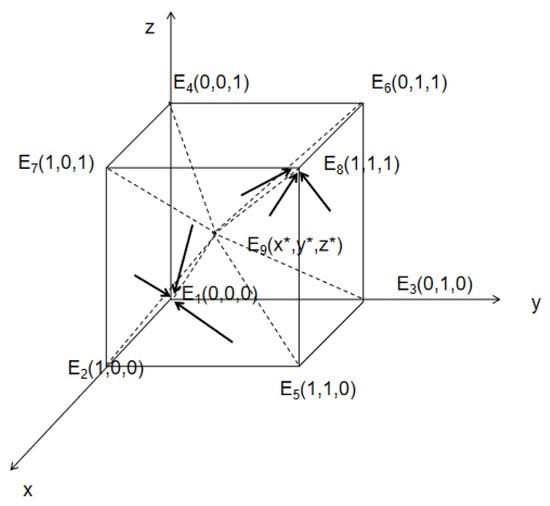 Figure 1. Tripartite main body dynamic evolution trend chart before a Public Health Emergency (About E9).
Figure 1. Tripartite main body dynamic evolution trend chart before a Public Health Emergency (About E9). Table 3. The effect of the parameter changes on the action strategy.
Table 3. The effect of the parameter changes on the action strategy.
3. Evolutionary Game of SME Social Responsibility after a Public Health Emergency
3.1. Problem Description
The 2020 COVID-19 pandemic is an unprecedented global public health crisis (“COVID-19”). By the end of December, the COVID-19 outbreak had spread to 218 countries, with more than 83 million confirmed cases worldwide and more than 1.8 million deaths (World Health Organization, WHO, 2020). After October 2020, there was a second outbreak of COVID-19 in many countries, and the number of confirmed cases has doubled worldwide in just two months [42]. The outbreak of COVID-19 has caused great trauma to the Chinese economy and even the global economy, and the impact of the epidemic has left thousands of companies floating on the brink of bankruptcy [43]. The epidemic caused the loss of the industrial added value of Chinese small and medium-sized service enterprises by about 2.3 to 2.6 trillion yuan in 2020, and the loss of main business revenue was about 7.2–8.1 trillion yuan. The epidemic will have a huge impact on small and medium-sized service enterprises in China in the short and medium term [44]. During a major public health emergency, corporate social responsibility is not only a moral embodiment but also a method of brand building, which can establish a good corporate image and improve the reputation of enterprises. During this period, the responsibility of SMEs to society is reflected in delivering materials and donating funds to the disaster-hit areas of public health emergencies, ensuring the material and capital needs of the front line, abiding by laws and ethics, and operating legally and in compliance. Ding et al. [45] found that companies that invested more in CSR before the COVID-19 pandemic performed better in response to the COVID-19 pandemic. Ling et al. [43] found through empirical research that when companies with higher social responsibility scores encountered the impact of sudden external events and weaker agency problems due to good internal governance ability, the company could better fulfill the shareholder responsibility, which plays an important role in stabilizing the stock price. Companies that contribute much to society are often more recognized by society. In the event of a sudden social crisis, the probability of their shareholders selling shares will be lower than the shareholders of companies that poorly fulfill their social responsibilities. Therefore, during major public health emergencies, enterprises that actively practice social responsibility can achieve a win–win situation between commercial value and social value. When a public health event occurs, some companies will have an impact on their profits and expenditures by actively fulfilling their social responsibilities. For this reason, we build the evolutionary game model for analysis according to the above practical situation.
3.2. The Basic Assumptions of the Model
In light of the above situation, we discuss the evolutionary game of SMEs fulfilling their social responsibility after public health emergencies. The government regulatory agencies will give more tax incentives to SMEs that actively fulfill their corporate social responsibility, and the tax incentive function is . Accordingly, the payment matrix of government regulatory agencies, SMEs, and consumers after public health emergencies is shown in Table 4. According to the above assumptions, the payment matrix of the three-way game is shown in Table 4.

Table 4.
Payment matrix of government regulatory agencies-SME-Consumer game stage after public health emergencies.
3.3. Government Regulatory Agencies, Small and Medium-Sized Enterprises, Consumer Replicator Dynamics Equation Construction
3.3.1. Replicator Dynamics Equation of Government Regulatory Agencies
When the government regulatory agencies choose strict regulation, the expected return is:
The expected return when not regulated is:
The government regulatory agencies’ replicator dynamics equation:
3.3.2. Replicator Dynamics Equation of SMEs
The expected income of SMEs when they actively perform is
The expected return on negative performance is:
Replicator dynamics equations for SMEs:
3.3.3. Replicator Dynamics Equation of Consumers
The expected earnings from positive consumer reviews are as follows:
The expected benefit from negative reviews by consumers is:
Consumer’s replicator dynamics equation:
Formula (6), formula (7), and formula (8) stand together, and the replication power system of the government regulatory agencies, small and medium-sized enterprises, and consumers are:
According to the method proposed by Friedman, the Evolutionary Stability Strategy (ESS) of the differential equation can obtain the Jacobian matrix of the system as follows:
Notes: .
In the system (9), ① with , the local equilibrium points are . ② There may be a mixed equilibrium point where and satisfy the following equation:
Then we can solve for:
Notes: .
According to evolutionary game theory, when satisfying the eigenvalues of the Jacobian matrix, , it is the evolutionary stability point (ESS) of the system.
3.4. Stability Analysis of the Equilibrium Points
By substituting the nine equilibrium points into the Jacobian matrix (10), respectively, the eigenvalues of the Jacobian matrix corresponding to the equilibrium points are shown in Table 5.

Table 5.
Eigenvalues of the Jacobian matrix.
Case 4.
When , that is, the income of the government regulatory agencies’ strict supervision is higher than the sum of the cost under its strict supervision and subsidies and additional subsidies for actively fulfilling corporate social responsibility. Furthermore, the benefits and subsidies of enterprises actively fulfilling social responsibility are greater than the benefits and costs of passively fulfilling corporate social responsibility. Small and medium-sized enterprises actively fulfill their corporate social responsibility to bring benefits to consumers that are less than the expenditure contributed by consumers to actively fulfill their corporate social responsibility. At this time, there is a stable point, , in the replicator dynamics system. The corresponding eigenvalues of Jacobian are all negative. The corresponding evolutionary strategy is for the government regulatory agencies to strictly supervise, small and medium-sized enterprises choose to actively fulfill corporate social responsibility, and consumers choose to give negative evaluations.
Case 5.
When , that is, the benefit from strict government regulatory agencies’ supervision exceeds the sum of the cost under its strict supervision and subsidies and additional subsidies for actively fulfilling corporate social responsibility. Moreover, the benefits and subsidies of enterprises actively fulfilling social responsibility are greater than the benefits and costs of passively fulfilling corporate social responsibility. Small and medium-sized enterprises actively fulfill their corporate social responsibility to bring benefits to consumers that are greater than the expenditure contributed by consumers to actively fulfill their corporate social responsibility. At this time, there is a stable point of . The corresponding characteristic values of Jacobian are negative. The corresponding evolutionary strategy is for the government regulatory agencies to strictly supervise, small and medium-sized enterprises choose to actively fulfill corporate social responsibility, and consumers choose to give positive evaluations.
Case 6.
- When ; , at this time, there is an inner stable point in the replicator dynamics equation, which means that the government regulatory agencies, small and medium-sized enterprises, and consumers, respectively, choose strict supervision, active implementation, and positive evaluation with a certain probability. At first, the government regulatory agencies choose not to strictly regulate them because they want to obtain certain benefits, and they have performed well. Small and medium-sized enterprises, due to lax supervision, negatively perform their corporate social responsibility. Consumers choose to make negative evaluations of small and medium-sized enterprises because of their negative performance of corporate social responsibility and reduce the purchase of goods from negative social responsibility enterprises. Thus, the efficiency of small and medium-sized enterprises decreases, the business environment is poor, and environmental pollution is serious. After the discovery of this phenomenon, the government regulatory agencies urgently seek rectification and choose to improve strict supervision. Finally, under the strict supervision of government regulatory agencies, small and medium-sized enterprises choose to actively fulfill their corporate social responsibility to a certain extent. The probability of consumers giving positive evaluations to enterprises increases. Therefore, the three main bodies will choose the mixed strategy in the constant dynamic game.
- When or , at this time, the E9(x*,y*,z*) is the unstable point. It shows that the probabilities of government regulatory departments, small and medium-sized enterprises, and consumers are constantly changing internally, as shown in Figure 2. The probability of final convergence to a given state is dependent on the phase volume. The analysis of the influence of the different influencing factors is shown in Table 6. Influencing factors include the regulatory intensity of government regulatory authorities , earnings from active performance, punishment and loss from negative performance, and additional tax benefits. When these influencing factors increase, x*, y*, and z* all decrease, and E9 is close to E1(0,0,0), and thus the phase volume composed of the stabilization strategy E8(1,1,1) increases, then the probability that the three subjects will choose the (active supervision, active performance, positive evaluation) action strategy increases.
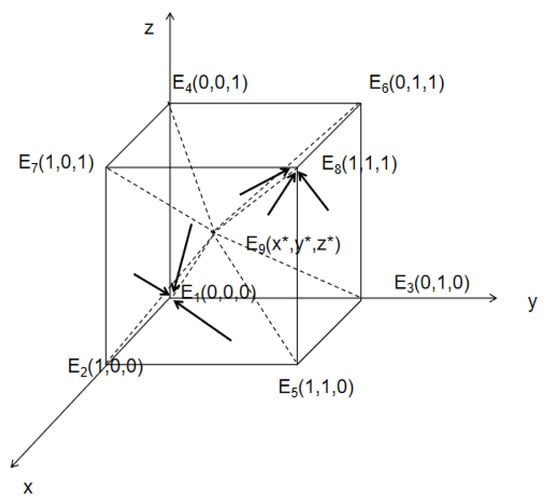 Figure 2. Tripartite main body dynamic evolution trend chart after a Public Health Emergency (About E9).
Figure 2. Tripartite main body dynamic evolution trend chart after a Public Health Emergency (About E9). Table 6. The effect of the parameter changes on the action strategy.
Table 6. The effect of the parameter changes on the action strategy.
4. Numerical Simulation and Discussion
By analyzing the evolutionary process of the government regulatory agencies, SMEs, and consumers before and after the emergency, the replicator dynamics Equations (1)–(3), (4)–(6) are obtained, involving the benefits of different strategy combinations and the probability distribution of different strategies or variables, in the Jacobian matrix to determine the stability of the evolutionary system in the equilibrium point, but it is difficult to detail the process of realizing equilibrium and the influence of different parameters on the evolutionary process. Moreover, due to the high instability and uncertainty of the tripartite game process, it is difficult to directly observe and study the development process of the event itself. In order to analyze the evolutionary game process among the government regulatory agencies, SMEs, and consumers under different situations, this paper adopts the numerical analysis method to verify the theoretical analysis, that is, to simulate the changing trend of the game among government regulatory agencies, SMEs, and consumers by valuing the model parameters. The evolution of uncertainty strategies among stakeholders is simulated through scenarios, which facilitates a more intuitive understanding of the internal dynamic evolution of events [46].
The parameter setting is analyzed, and the parameter selection in the numerical simulation part of the conventional evolutionary game has a certain subjectivity [47]. However, reasonably setting the parameters of numerical simulation is a necessary prerequisite for an effective numerical simulation [48]. In order to solve this problem, there are mainly two main common methods to set the range of parameter value, namely: literature and real-world investigations and the equality balance principle [49]. In this paper, Qianjin Pharmacy is selected as the representative company to actively fulfill corporate social responsibility, and Xiangxue Pharmaceutical is selected as the parameter of the negative performance of corporate social responsibility. The data before the public health emergency selects the arithmetic average for 2018 and 2019, and the data after the public health emergency selects the arithmetic average for 2020 and 2021. The unified unit is one million yuan. Among them, when the government regulatory agencies choose strict regulation, the revenue is , the regulatory cost is , government regulatory agency regulation , and the government regulatory agency loss during a negative performance of corporate social responsibility is , and SMEs can get short-term gains of . The total capital owned by the enterprise that chooses to actively fulfill its social responsibility is . This include cash and inventory . We select the total capital 13, including cash share and inventory . The negative cost of SMEs fulfilling CSR is , and the incremental cost of actively fulfilling CSR is . The government regulatory agencies give a tax subsidy of W = 8 to small and medium-sized enterprises that actively fulfill their corporate social responsibility, and the failure to do so is punished by the government regulatory agencies as K = 6. If the government regulatory agencies do not strictly supervise, small and medium-sized enterprises negatively fulfill their social responsibilities, and consumers give negative evaluations, the government regulatory agency additional loss , and the enterprise increases its reputation loss . The additional purchasing expenditure is 2, and SMEs actively fulfilling corporate social responsibility will bring profits to consumers , and the negative performance of corporate social responsibility to SMEs will bring losses to consumers.
In summary, the stochastic evolution of the strategy is simulated using MATLAB software. This paper explores the results of the tripartite evolution both before and after public health emergencies. Among them, indicates the initial probability of the government regulatory agencies choosing to adopt a strict supervision strategy, indicates the initial probability of SMEs choosing to actively fulfill corporate social responsibility, indicates the initial probability of consumers choosing to positively evaluate the enterprise, and the abscissa t is the time of the evolutionary game. We set the initial participation willingness of the government regulatory agencies, SMEs, and consumers at 0.5.
The initial parameters for the simulation analysis are 5, 3, .
4.1. Evolutionary Path of SMEs’ Fulfillment of Social Responsibilities before Public Health Emergencies
4.1.1. The Influence of Different Initial Strategic Choices on the System Evolution
In Figure 3, it is shown that under different initial strategies, SMEs will eventually choose to fulfill their corporate social responsibility with the increasing initial proportion. Similarly, as the number of evolutions increases, the 3D evolutionary simulation diagram objectively shows the obvious evolutionary trend of the combination of subject strategies. In the end, the government regulatory agencies will choose an active regulatory strategy, SMEs will choose to actively fulfill their corporate social responsibility, and consumers will choose to give positive comments.
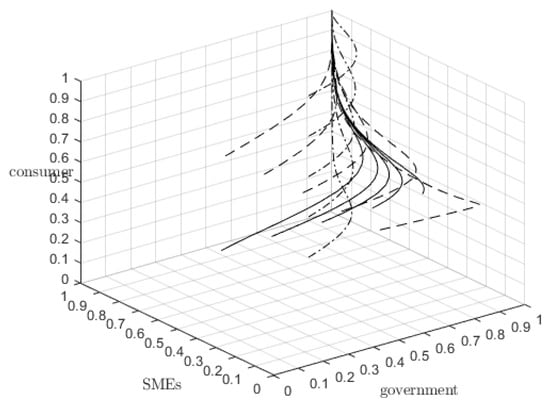
Figure 3.
Before a public health emergency, the government regulatory agencies–SMEs–consumers (Three-dimensional stereogram).
In Figure 4, to change the initial intention of the tripartite subjects, the initial values are 0.2, 0.5, and 0.7, respectively. On the whole, as the initial probabilities x, y, and z of the three main bodies increase continuously, x, y, and z all converge to 1 and finally reach the equilibrium point (1,1,1). When the initial value is less than 0.2, the participation willingness of SMEs and consumers is not very strong. The time span of reaching equilibrium is long, eventually converging to (x*,y*,z*). When the initial probability of the three parties is too small, they will choose the mixed strategy. The simulation results show that the government regulatory agencies are in a leading position in the evolutionary process of SMEs’ social responsibilities, and the government regulatory agencies’ strong initial willingness will lead SMEs and consumers to accelerate the equilibrium speed. Therefore, in the process of fulfilling corporate social responsibility, the guiding role of the government regulatory agencies is very important, and the government regulatory agencies need to formulate more perfect and reasonable relevant policies to guide small and medium-sized enterprises to actively fulfill corporate social responsibility. Small and medium-sized enterprises should also follow the pace of government regulatory agencies, cooperate with relevant policies, and actively fulfill their corporate social responsibility.
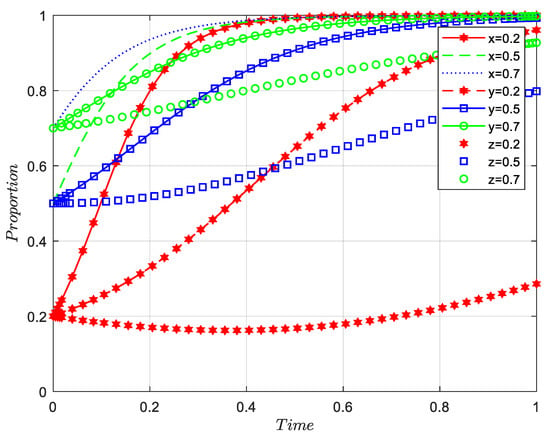
Figure 4.
Before a public health emergency, the government regulatory agencies–SMEs–consumers (Two-dimensional graph).
4.1.2. Influence of Rewards and Punishments on System Evolution
The impact of the punishment is K given by the government regulatory agencies on the system evolution. Based on the initial scenario, we keep the other parameters unchanged and set the initial probabilities to (0.2,0.2,0.2), simulating the effect of the government supervision department’s penalty K for SMEs on the stabilization strategy of system evolution. Let K be 1, 6, 30, 50, and 100, respectively, the evolutionary path of the simulated system, as shown in Figure 5.
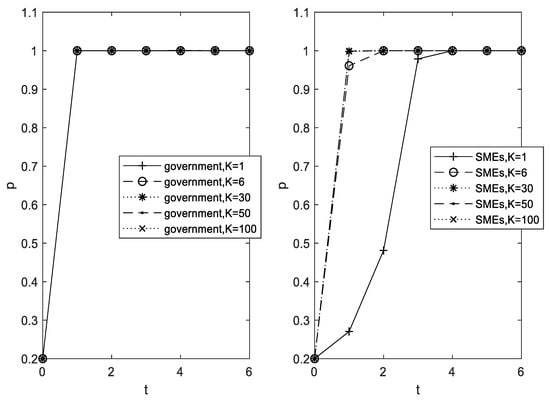
Figure 5.
The effect of government regulatory agencies’ punishment on the negative performance of CSR K on the results of system evolution.
As can be seen from Figure 5, on the whole, with the increase of K, that is, when the government regulatory agencies’ punishment for the negative performance of corporate social responsibility increases, it has little impact on the government regulatory agencies themselves, but it has a great impact on small and medium-sized enterprises. Specifically, when K takes a very small value, SMEs are not strongly motivated to fulfill their corporate social responsibility, and at this time, government regulatory agencies’ small punishment does not form a deterrent to small and medium-sized enterprises. However, as K becomes larger, SMEs will choose to actively fulfill their corporate social responsibility, and with the gradual increase in K, the time for the Evolutionary Stability Strategy of SMEs is gradually shortened. The reason is that before a public health emergency, small and medium-sized enterprises can carry out daily production activities step by step. With the government regulatory agencies’ increased punishment for small and medium-sized enterprises, SMEs will be willing to actively fulfill their corporate social responsibility under the government regulatory agencies’ supervision and punishment measures, and the greater the punishment, the earlier they will reach the evolutionary and stable equilibrium point.
4.2. Evolutionary Path of SME Social Responsibility Performance after a Public Health Emergency
The evolution of an SMEs’ corporate social responsibility is after considering public health emergencies. Among them, the government regulatory agencies will give more tax incentives of T = 5 to SMEs that actively fulfill their corporate social responsibility, and other parameters are consistent with the parameter values before public health emergencies.
4.2.1. The Effect of Different Initial Strategy Choices on the System Evolution
In Figure 6, unlike before the aforementioned public health emergency, when the initial probabilities of the three parties are low, the time to evolve to the equilibrium point is longer. The reason is that when a public health emergency occurs, there is some impact on all three parties, the downward economic pressure is great, enterprises face a crisis, and many small and medium-sized enterprises have no extra money to maintain corporate social responsibility activities. Therefore, the time for the three parties to evolve to the equilibrium point becomes longer. However, when the initial intention of the three parties is high, the time for the three parties to evolve to the equilibrium point is shorter than that before the public health emergency. This shows that in the face of public health emergencies, as long as the three parties work together, the three subjects can still quickly reach the equilibrium point and help the whole society to get out of the crisis as soon as possible. In Figure 7, when the initial probabilities of the three parties are 0.2 and 0.5, the government regulatory agencies are still in a guiding position, reaching the equilibrium state faster than small and medium-sized enterprises and consumers and driving small and medium-sized enterprises and consumers to reach the equilibrium state. However, as can be seen from the figure, when the initial probability is 0.7, unlike the public health events mentioned before, SMEs are in a leading position, which will drive the government regulatory agencies and consumers to actively implement their action plans. The reason is that when public health emergencies occur, the economy is in a period of “depression.” If small and medium-sized enterprises can actively fulfill their corporate social responsibility well, they can drive economic development and operation. Therefore, after the occurrence of public health emergencies, small and medium-sized enterprises must assume their own responsibilities and actively fulfill their corporate social responsibility so as to better promote economic development and promote faster economic operation and recovery.
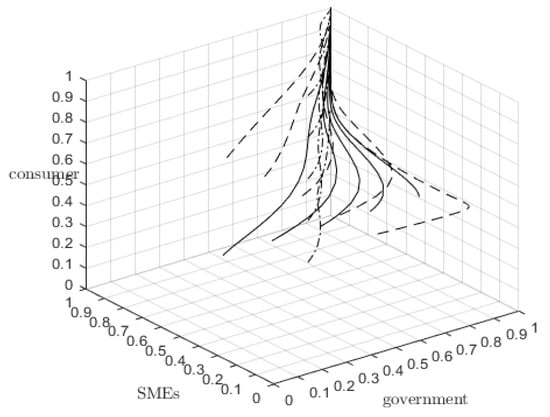
Figure 6.
Government regulatory agencies–SME–consumer after public health emergencies (Three-dimensional stereogram).
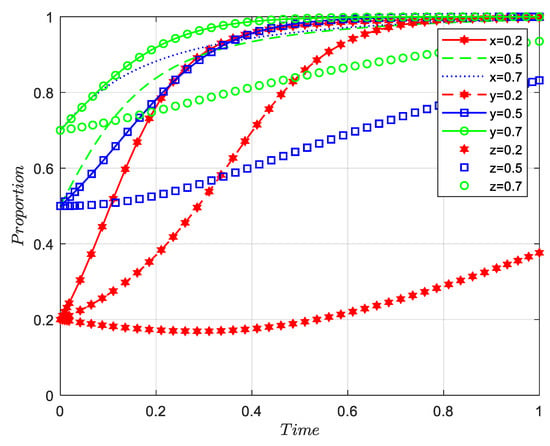
Figure 7.
Government regulatory agencies–SME–consumer after public health emergencies (Two-dimensional graph).
4.2.2. The Government Regulatory Agencies Will Give More Tax Incentives to SMEs That Actively Fulfill Their Corporate Social Responsibilities T for the Impact on the Evolution of the System
In the initial scenario, other parameters are kept unchanged, and after the public health emergency is simulated, the government regulatory agencies give more tax incentives T to SMEs that actively fulfill corporate social responsibility in the system evolution. Let T = 1, 8, 10, 13, 17, and simulate the evolutionary path of the system, as shown in Figure 8 and Figure 9.
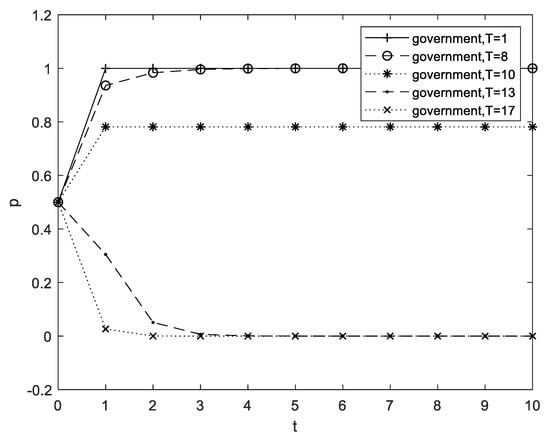
Figure 8.
After a public health emergency, government regulatory agencies give more tax incentives T to SMEs that actively fulfill their corporate social responsibility in system evolution (About government regulatory agencies).
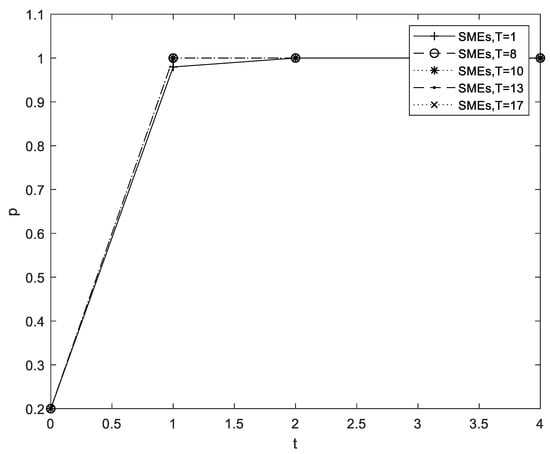
Figure 9.
After a public health emergency, government regulatory agencies give more tax incentives T to SMEs that actively fulfill their corporate social responsibility in system evolution (About SMEs).
Figure 8 and Figure 9 show the impact of T on the evolution of government regulatory agencies and SMEs after a public health emergency. In the range of T < 10 with an initial government regulatory agency probability of 0.5, as T increases, the government regulatory agencies slow down to reach equilibrium points tightly regulated. At T > 13, the government regulatory agencies choose to change their strategy and regulate SMEs negatively. The reason is that after the public health emergency, the government regulatory agencies’ financial situation is also not making ends meet; they give enterprises too many subsidies and will enter a fiscal turnover crisis. Thus, the appropriate fiscal subsidies can keep the government regulatory agency turnover stable and can promote small and medium-sized enterprises actively fulfilling enterprise social responsibility and help them to survive after the public health emergency. Under the condition of the initial probability of small and medium-sized enterprises being 0.2, with the increase of T, small and medium-sized enterprises choose to actively fulfill their corporate social responsibility to speed up, and more incentive subsidies have an incentive effect for small and medium-sized enterprises. In public health emergencies, small and medium-sized enterprises have survival difficulties and may not be able to actively fulfill their corporate social responsibility, but with the support and help of the government regulatory agencies, they will be more willing to actively fulfill their corporate social responsibility. To sum up, we set T at (8, 10). At this time, the government regulatory agencies and small and medium-sized enterprises achieve the best benefits, the government regulatory agencies choose to actively supervise, and small and medium-sized enterprises choose to actively fulfill their corporate social responsibility.
4.2.3. The Influence of Game Player’s Action Strength on the System Evolution
The change in government regulatory agency supervision will have an impact on the dynamic trajectory of system stabilization. Other parameters remain unchanged in the initial scenario, separately simulating the effect of regulatory on the evolution of the system. The initial participation probability of the three parties remains unchanged, all being 0.5. The value range of is (0, 1); let be 0.1, 0.5, 0.7, 0.8, and 0.9, respectively, to simulate the evolutionary path of the system, as shown in Figure 10.
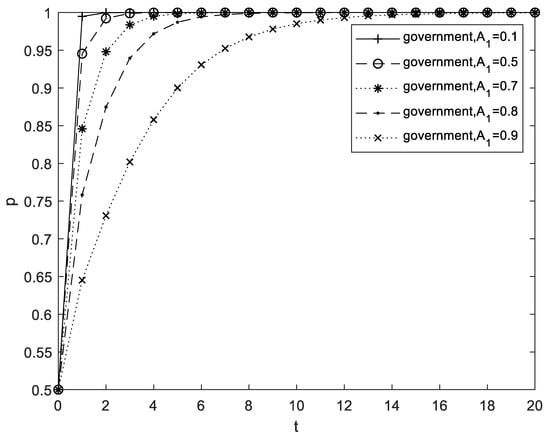
Figure 10.
The influence of government regulatory agencies’ regulation on the results of the system evolution.
As can be seen from Figure 10, compared with the initial state, with the increase in , that is, the increase in the government regulatory agencies’ supervision, the time for the government regulatory agencies to reach equilibrium is getting longer and longer, and the government regulatory agencies are more and more unwilling to actively regulate whether small and medium-sized enterprises perform their corporate social responsibility. However, the increase in has no significant impact on the time for SMEs and consumers to reach equilibrium. The reason is that under public health emergencies, the national economy is facing a great impact. The greater the government regulatory agencies’ supervision is, the more cost it bears. Because the government regulatory agencies itself is also facing huge financial pressure, if the supervision cost is too high, the government regulatory agencies are not willing to take strong supervision. It can be seen that when the crisis comes, the implementation intensity of the government regulatory agencies is closely related to the cost of government regulatory agencies’ supervision. When choosing the regulatory strategy, the government regulatory agencies should pay attention to the cost plan, choose the appropriate regulatory cost, and establish a sufficient cash pool in case of an emergency.
4.2.4. Influence of Rewards and Punishments on System Evolution
- (1)
- The effect of government regulatory agencies’ incentive W for SMEs on system evolution
In the initial scenario, the other parameters are kept unchanged, and the same initial probabilities are also used, i.e., (0.5, 0.5, 0.5), to simulate the impact of the government regulatory agencies’ incentive W to SMEs on the evolution of the system. Let W be 1, 8, 15, 18, and 30, respectively, and the evolutionary path of the simulated system is shown in Figure 11.
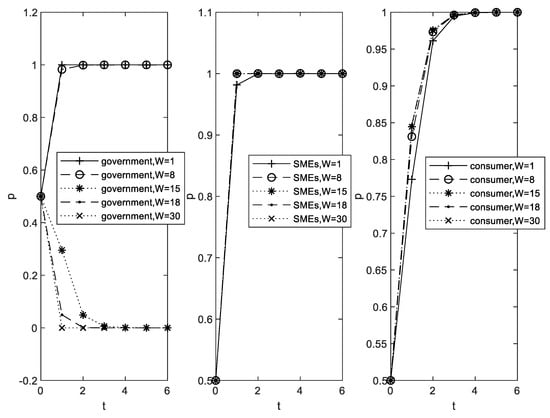
Figure 11.
Impact of government supervision department incentives to SMEs on the results of system evolution.
As can be seen from Figure 11, compared with the initial scenario, when the participation willingness of the government regulatory agencies, SMEs, and consumers are all at the middle level, the government regulatory agencies’ incentive policies will directly affect the system evolution’s results. With the increase of W, the time for SMEs to actively fulfill their corporate social responsibility is gradually shortened, and the time for consumers to give positive evaluations is also gradually shortened. At the same time, when W increases to a certain extent, the government regulatory agencies will change their strategy and choose negative regulation. Specifically, the greater the government regulatory agencies’ incentive to SMEs, and the more financial support for them to fulfill their corporate social responsibility, the more willing SMEs will be to actively fulfill their corporate social responsibility. However, from the perspective of the W value range, under public health emergencies, when government regulatory agencies’ incentives to SMEs are too low, SMEs may be unable to fulfill corporate social responsibility due to lack of funds; excessive government supervision department incentives to SMEs will cause an excessive burden on the government regulatory agencies, thus causing the government regulatory agencies to change strategies and implement negative supervision. Thus, the government regulatory agencies’ incentive degree for small and medium-sized enterprises needs to be maintained within a reasonable range (8, 15). At that time, the government regulatory agencies will choose strict regulation, small and medium-sized enterprises will choose to actively fulfill corporate social responsibility, and within the range, the government regulatory agencies and small and medium-sized enterprises’ execution efficiency will reach the highest state, and consumers will actively give positive evaluation.
- (2)
- Comparison of dynamic-equilibrium and nonequilibrium strategies
The government regulatory agencies’ subsidy policy has a positive impact on SMEs to fulfill their corporate social responsibility, but in the long run, the government regulatory agencies may face financial problems [50]. Especially in public health emergencies, governments are more likely to spend more than they take in. Therefore, this paper refers to the budget balance policy proposed by Li Wanhong et al. [51]. The government regulatory agencies will punish the enterprises that negatively fulfill their social responsibilities and take taxation as the main form of punishment to balance the subsidies for the enterprises that actively fulfill their social responsibilities so as to avoid financial problems. In addition, the policies considered in this paper all change as the proportion of enterprises changes to fulfill their social responsibilities, so we discuss different dynamic balance strategy situations. The first is the static balance between the government regulatory agencies’ tax revenue and the subsidy, and the other is that the subsidy and the tax revenue change dynamically with the proportion of the number of corporate social responsibility enterprises actively fulfilling them. The dynamic balance strategy .
As shown in Figure 12, compared with Figure 5, the efficiency of the government regulatory agencies’ implementation strategy is improved under the dynamic balance strategy. For government regulatory agencies, SMEs, and consumers, excessive subsidies and taxes will lead to their choice to execute negatively, and with the increase of subsidies and taxes, the speed of the three parties evolving to the equilibrium point slows down. Moreover, this figure can further verify that the scope of government regulatory agencies’ subsidies and penalties for small and medium-sized enterprises is (8, 15).
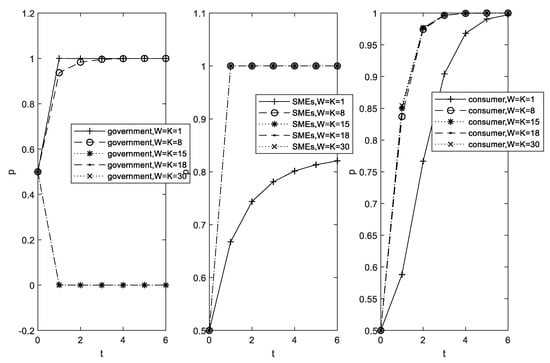
Figure 12.
Evolution of different dynamic strategy policy criteria.
4.2.5. Impact of Cash and Inventory on System Evolution
We keep other parameters unchanged and change the impact of their cash and inventory on the evolution of the system when SMEs actively perform and passively fulfill their corporate social responsibility. When small and medium-sized enterprises actively perform their corporate social responsibility, the value of the cash held, , is 1, 5, 8, 15, 30, respectively, simulating the system evolution path, as shown in Figure 13. When small and medium-sized enterprises perform their corporate social responsibility negatively, the value of the inventory is 1, 10, 15, 16, and 20, respectively, simulating the system’s evolutionary path, as shown in Figure 14.
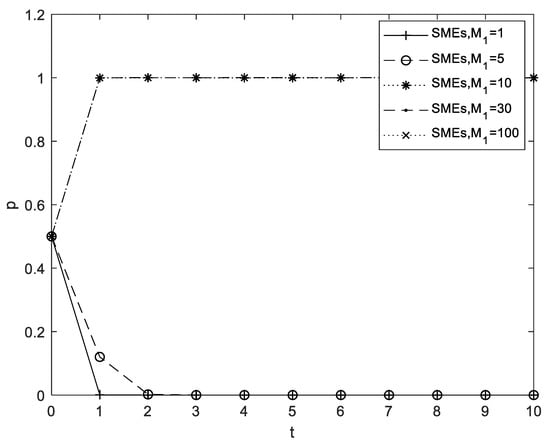
Figure 13.
Effect of cash on the system evolution.
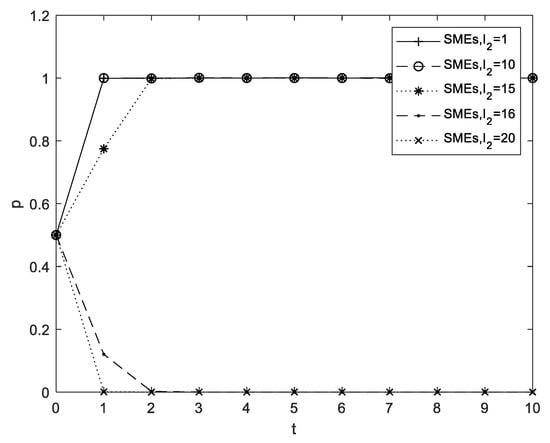
Figure 14.
Effects of inventory on the system evolution.
As can be seen from Figure 13, under the premise that the initial conditions remain unchanged, with the increase of , that is, the more cash that SMEs hold when they actively fulfill corporate social responsibility, the shorter the time for SMEs to achieve the evolutionary and stable equilibrium point of actively fulfilling corporate social responsibility. When is less than eight units, small and medium-sized enterprises are seriously short of cash, and they choose to fulfill their corporate social responsibility negatively. The reason is that the more cash held by small and medium-sized enterprises, the more crisis occurs; capital turnover is more flexible, and they have the power and ability to actively fulfill corporate social responsibility. When small and medium-sized enterprises have cash shortages, they need to ensure their normal operating expenses and normal operation so they will not choose to actively fulfill corporate social responsibility. The fulfillment of corporate social responsibility requires part of the cost expenditure. Enterprises with insufficient cash flow are powerless to cope with the crisis, so they will choose not to fulfill corporate social responsibility. From Figure 14, we see that if the initial conditions remain unchanged, there will be an increasing . When is greater than 15 units, small and medium-sized enterprises will choose to change their strategy; that is, when the inventory held by small and medium-sized enterprises reaches a certain extent, they will change their strategy and choose to fulfill corporate social responsibility negatively. The reason is that in public health emergencies, consumer purchase intention begins to decline, and the economic situation is not optimistic. The more small and medium-sized enterprise inventory, consumption stagnation, and product backlog there is in the inventory, the more products cannot be sold. The enterprise also faces the capital turnover problem, so it will change its strategy and choose not to fulfill its corporate social responsibility. Thus, it can be seen that small and medium-sized enterprises need to do a good job in their own cash inventory management, only to ensure a certain level of cash inventory in order to better fulfill corporate social responsibility.
Therefore, due to their poor financial situation, some small and medium-sized enterprises need to prepare sufficient cash in public health emergencies, and holding excessive inventory will lead to poor capital turnover.
4.2.6. Effect of Incremental Revenue and Incremental Cost on the System Evolution
- (1)
- The incremental cost of SMEs actively fulfilling CSR is the impact of on system evolution
In the initial scenario, the other parameters remain unchanged to simulate the impact of the incremental cost of SMEs on the evolution of the system. Let be 1, 6, 10, 30, and 50 for the evolutionary path of the simulated system, as shown in Figure 15.
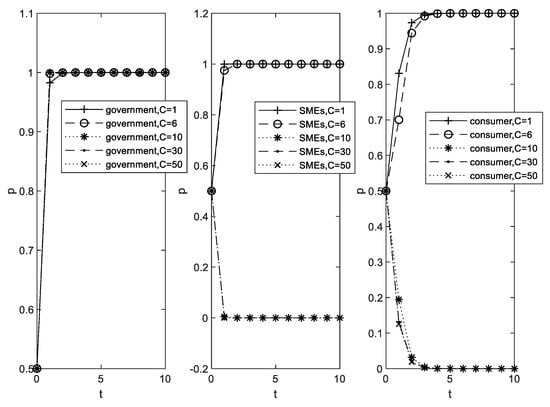
Figure 15.
The impact of incremental cost on system evolution.
As can be seen from Figure 15, under the premise of unchanged initial conditions, when , SMEs will choose to actively fulfill corporate social responsibility. With the increase in C, it takes longer for SMEs to reach the stable equilibrium point of the evolutionary game of actively fulfilling CSR. When , SMEs will change their strategy and choose to fulfill corporate social responsibility negatively. The reason is that whether SMEs are willing to actively fulfill their corporate social responsibility is highly sensitive to the cost incurred in public health emergencies. When the cost exceeds the income, SMEs will choose to negatively fulfill their corporate social responsibility. When the cost of SMEs to fulfill their social responsibilities is too high, consumers are not willing to give SMEs a positive evaluation. The reason is that when the cost of small and medium-sized enterprises is too high, part of the costs brought by the enterprises to fulfill their corporate social responsibility will be transferred to consumers in the form of rising product prices, which virtually increases the daily expenses of consumers. So even if the companies fulfill their social responsibilities in place, the final product price rises, and consumers are also reluctant to give positive reviews to companies.
- (2)
- Consumers who give positive reviews will have the impact of additional purchasing spending on the system evolution.
In the initial scenario, the other parameters remain unchanged and simulate the impact of consumers on the system evolution of additional purchasing spending on SMEs that actively fulfill corporate social responsibility. Let be 2, 3, 4, 5, and 10, respectively, the evolutionary path of the simulated system, as shown in Figure 16.
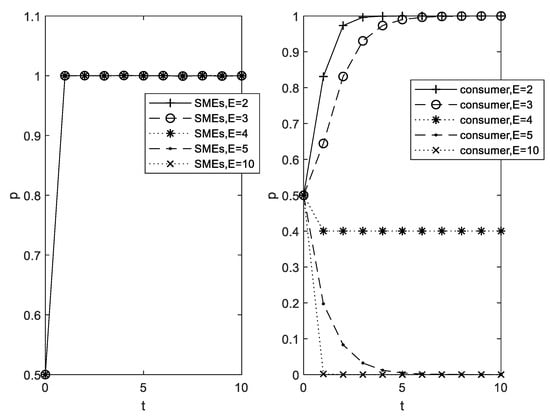
Figure 16.
The additional purchasing expenditure E for SMEs who give positive reviews on system evolution.
As can be seen from Figure 16, for SMEs, no matter how much E value is taken, they will choose to actively fulfill their corporate social responsibility. As long they have the support of consumers, the enterprise will have the incentive to actively fulfill the corporate society. For consumers, when , that is, when consumers give less than four additional units of purchasing expenditure to enterprises that actively fulfill corporate social responsibility, consumers will choose to make a positive evaluation of the enterprise, and with the increase in E, the longer the time for consumers takes to reach the equilibrium point of the evolutionary stability strategy. When , the consumer chooses to give negative comments. The reason is that consumers spending too much to support SMEs to actively fulfill their corporate social responsibility will allow them to make ends meet. During the epidemic, the economy stagnated, and consumers were quarantined at home and had no source of income. Therefore, only making E within the appropriate scope can not only make SMEs more motivated to actively fulfill their corporate social responsibility but also let consumers support and cooperate with small and medium-sized enterprises to fulfill their corporate social responsibilities and give them positive comments.
5. Conclusions
On the premise of bounded rationality of game parties, this paper uses evolutionary game theory to study the evolution process of corporate social responsibility before and after public health emergencies in which the government regulatory agencies, SMEs, and consumers participate. Combined with numerical analysis, the strategic behavior of government regulatory agencies, SMEs, and consumers to fulfill CSR and its influencing factors are investigated. The conclusions are as follows, and some suggestions are put forward for the three parties:
- (1)
- The government regulatory agencies, before and after the public health emergency, play a leading role in the whole evolutionary process. The government regulatory agencies need to formulate more perfect and reasonable relevant policies to guide small and medium-sized enterprises to actively fulfill their social responsibilities. Government regulatory agencies should also pay attention to the management of regulatory costs so as not to cause an excessive financial burden on the government regulatory agencies. The subsidies and penalties for small and medium-sized enterprises should be appropriate. It is suggested to adopt a dynamic balance strategy within the reasonable scope of (8, 15), which can effectively prevent a financial crisis for the government regulatory agencies. In particular, after a public health emergency, when the whole social economy is depressed, the initial willingness of small and medium-sized enterprises to participate in corporate social responsibility is relatively low, and the government regulatory agencies should take the initiative to stimulate the economy and play a guiding role. The government regulatory agencies need to establish a relatively sufficient emergency supply fund pool, give appropriate tax incentives to small and medium-sized enterprises that actively fulfill their corporate social responsibilities, and can quickly and effectively save the imminent bankruptcy during the crisis period, and provide appropriate liquidity for small and medium-sized enterprises, which plays an important role in alleviating the crisis.
- (2)
- Small and medium-sized enterprises are the main part of the process of fulfilling their social responsibility. We should closely follow the pace of the government regulatory agencies, cooperate with relevant policies, and actively fulfill our corporate social responsibility. In order to deal with public emergencies, we should do a good job in cash inventory management and reserve a certain amount of cash, but it is not a good choice to keep a large amount of inventory. Due to their small size, small and medium-sized enterprises are prone to produce financial crises when a crisis occurs. Therefore, in daily business activities, they should not only actively fulfill corporate social responsibility but also pay attention to the cost management of fulfilling corporate social responsibility. They should actively participate in corporate social responsibility activities, improve corporate governance, enhance the external reputation, and participate in social contributions to the donations so as to improve the company’s social reputation, establish a good image of the enterprise in the hearts of consumers, and obtain the support of consumers. This is the intangible property of the company. They also need to set aside a portion of the money to deal with the crisis to help companies overcome the difficulties in the event of a crisis.
- (3)
- For consumers, it is necessary to improve their preference strength for social responsibility, transform consumers from interest-oriented consumers to responsibility-oriented consumers, cultivate the responsible consumer market, expand the scale of responsible consumption, and give preferential support to small and medium-sized enterprises that actively fulfill corporate social responsibility. Thus, doing so can improve the willingness of enterprises to actively fulfill corporate social responsibility and better maintain the survival and development of small and medium-sized enterprises in the crisis.
- (4)
- Although the expected research objective of this paper has been achieved, there are still some defects in this paper. The subjects involved in the fulfillment of the social responsibilities of SMEs in this paper not only include government regulatory authorities, SMEs, and consumers but also involve some intermediaries, such as banks and other financial institutions. We have not yet taken these intermediaries into account. Next, the foundations of evolutionary game theory are based on the assumption that there are large populations of players [52]. However, the government may not count as a large population. In order to solve this problem, this paper changes the government, one of the game players in the evolutionary game, into the government regulatory agencies. Such modification has effectively alleviated the problem. However, there are still some limitations, which are explained here. In addition, some model assumptions and parameter settings in this paper mainly consider China’s domestic scenarios, including China’s economic and institutional conditions. Therefore, the international economic and institutional situation is not within our study. Nevertheless, in fact, public health emergencies have global infectiousness. Once a national crisis breaks out, a series of crises will affect the global economy and development situation. The influence of each country is reciprocal. This is what this article lacks. In future studies, we will consider the interests of more groups as well as the interaction between group interests.
Author Contributions
Software, Y.T.; Formal analysis, Y.T.; Resources, H.H.; Writing—original draft, Y.T.; Writing—review & editing, N.X.; Supervision, N.X. All authors have read and agreed to the published version of the manuscript.
Funding
This work was supported by the National Natural Science Foundation of China (No. 71901094), National Natural Science Foundation of China (No. 72091515), the Natural Science Foundation of Hunan Province (No. 2020JJ5378), the Scientific Research Project of Hunan Provincial Department of Education (No.18C1561), Postgraduate Scientific Research Innovation Project of Hunan Province (CX20220467).
Data Availability Statement
Not applicable.
Acknowledgments
The authors would like to thank the anonymous reviewers and the editor for their careful reviews and constructive suggestions to help us improve the quality of this paper.
Conflicts of Interest
The authors declare no conflict of interest.
References
- Yang, Z.; Chen, Y.; Zhang, P. Macroeconomic impact, financial risk transmission and governance response under major public emergencies. J. Manag. World 2020, 36, 13–35+7. [Google Scholar]
- Wang, X.; Chen, H. Stakeholder-based Relationship between Corporate Social Responsibility and Corporate Value. J. Manag. Sci. 2011, 24, 29–37. [Google Scholar]
- Du, S.; Bhattacharya, C.B.; Sen, S. Maximizing business returns to corporate social responsibility (CSR): The role of CSR communication. Int. J. Manag. Rev. 2010, 12, 8–19. [Google Scholar] [CrossRef]
- Gao, R.; Xu, L.; Chen, S.; Lin, X. The impact of transaction motivation and prevention motivation on the company’s cash holdings under the COVID-19 outbreak. World Surv. Res. 2022, 06, 62–71. [Google Scholar]
- Yang, J.; Wu, W.; Cai, Z. The impact of CSR on the cash-holding value—Studies based on quantile regression models. Syst. Eng. Theory Pract. 2019, 39, 893–905. [Google Scholar]
- Meng, L.; Liu, F.; Duan, S.; Li, X.; Li, T. The impact of shared employee incident intensity on civic behavior under COVID-19—Based on the perspective of corporate social responsibility knowledge. Nankai Bus. Rev. 2022, 1–28. Available online: http://kns.cnki.net/kcms/detail/12.1288.f.20210316.1448.006.html (accessed on 9 February 2023).
- Servaes, H.; Tamayo, A. The impact of corporate social responsibility on firm value: The role of customer awareness. Manag. Sci. 2013, 59, 1045–1061. [Google Scholar] [CrossRef]
- Flammer, C. Does corporate social responsibility lead to superior financial performance? A regression discontinuity approach. Manag. Sci. 2015, 61, 2549–2568. [Google Scholar] [CrossRef]
- Lins, K.V.; Servaes, H.; Tamayo, A. Social capital, trust, and firm performance: The value of corporate social responsibility during the financial crisis. J. Financ. 2017, 72, 1785–1824. [Google Scholar] [CrossRef]
- Wu, W.; Tang, S.; Wei, S. Social responsibility, media concerns and corporate financial risks—Based on the empirical evidence of listed companies in China. J. Manag. 2022, 35, 124–141. [Google Scholar]
- Sobaih, A.E.E.; Gharbi, H.; Hasanein, A.M.; Elnasr, A.E.A. The Mediating Effects of Green Innovation and Corporate Social Responsibility on the Link between Transformational Leadership and Performance: An Examination Using SEM Analysis. Mathematics 2022, 10, 2685. [Google Scholar] [CrossRef]
- Strielkowski, W.; Guliyeva, A.; Rzayeva, U.; Korneeva, E.; Sherstobitova, A. Mathematical modeling of intellectual capital and business efficiency of small and medium enterprises. Mathematics 2021, 9, 2305. [Google Scholar] [CrossRef]
- Liang, X.; Liu, Y.; Xue, B. Exploration of Multi-dimensional Social Responsibility of SMEs in Major Public Health Emergency. J. Hebei Univ. Eng. (Soc. Sci. Ed.) 2020, 37, 91–94. [Google Scholar]
- Simpson, W.; Kohers, T. The Link between Corporate Social and Financial Performance: Evidence from the Banking Industry. J. Bus. Ethics 2002, 35, 97–109. [Google Scholar] [CrossRef]
- Wen, S.; Fang, Y. An Empirical Study on the relationship between Corporate Social Responsibility and Financial Performance—Panel data analysis from the stakeholder perspectives. China Ind. Econ. 2008, 10, 150–160. [Google Scholar]
- Yang, W.; Yang, S. An Empirical Study on the Relations between Corporate Social Responsibility and Financial Performance in the Chinese Situation—Based on the comparative analysis of large and small and medium-sized listed companies. Chin. J. Manag. Sci. 2016, 24, 143–150. [Google Scholar]
- Li, Z. Study on the Correlation of CSR and Corporate Value—From empirical evidence from Shanghai listed companies. China Ind. Econ. 2006, 02, 77–83. [Google Scholar]
- Ding, D.K.; Ferreira, C.; Wongchoti, U. Does it pay to be different? Relative CSR and its impact on firm value. Int. Rev. Financ. Anal. 2016, 47, 86–98. [Google Scholar] [CrossRef]
- Quan, X.; Wu, S.; Yin, H. Corporate social responsibility and stock price crash risk: “value tool” or “self-benefit tool”? Econ. Res. J. 2015, 50, 49–64. [Google Scholar]
- Kim, J.B.; Li, Y.; Zhang, L. Corporate tax avoidance and stock price crash risk: Firm-level analysis. J. Financ. Econ. 2011, 100, 639–662. [Google Scholar] [CrossRef]
- Huang, J.; Chen, L.; Ding, J. Corporate social responsibility, media coverage, and the risk of a stock price crash. Chin. J. Manag. Sci. 2022, 30, 1–12. [Google Scholar]
- Chen, J.; Zheng, H. Financing constraints, customer bargaining power and corporate social responsibility. Account. Res. 2020, 08, 50–63. [Google Scholar]
- Verrecchia, R.E. Essays on disclosure. J. Account. Econ. 2001, 32, 97–180. [Google Scholar] [CrossRef]
- Feng, L.; Xiao, X.; Cheng, X. The effect of social responsibility on corporate risk-is based on the analysis of China’s economic environment. Nankai Bus. Rev. 2016, 19, 141–154. [Google Scholar]
- Chen, C.; Zhang, J.; Li, M.; Pei, X.; Huang, J. Research on the Concept, Dimension and Measurement of SME Social Responsibility. Chin. J. Manag. 2015, 12, 1687–1694. [Google Scholar]
- Guo, Y. Research on the Social Responsibility Implementation Model of SMEs in China. Seeker 2011, 05, 40–42. [Google Scholar]
- Du, J.; Hu, D.; Zhang, Q. Research on Social Responsibility Reconstruction of SMEs in Digital Environment—Based on Major emergencies. J. Macro-Qual. Res. 2020, 8, 120–128. [Google Scholar]
- Carroll, A.B. Corporate social responsibility (CSR) and the COVID-19 pandemic: Organizational and managerial implications. J. Strateg. Manag. 2021, 14, 315–330. [Google Scholar] [CrossRef]
- Zheng, J.; Hu, Y. Can green credit drive the “greening” of financial system and enterprises’ emission reduction?—Based on evolutionary game analysis. Chin. J. Manag. Sci. 2023, 1–12. [Google Scholar] [CrossRef]
- Wang, X.; Gu, C.; Zhao, J.; Quan, J. Stochastic evolution dynamics and their cooperative mechanisms. J. Syst. Sci. Math. Sci. 2019, 39, 1533–1552. [Google Scholar]
- Wang, W. Research on Land Heavy Metal Pollution Regulation Strategy Based on Evolutionary Game and Simulation Analysis. Master’s Thesis, Jiangxi University of Finance and Economics, Nanchang, China, 2017. [Google Scholar]
- Wang, M.; Lian, S.; Yin, S.; Dong, H. A three-player game model for promoting the diffusion of green technology in manufacturing enterprises from the perspective of supply and demand. Mathematics 2020, 8, 1585. [Google Scholar] [CrossRef]
- Cui, H.; Wang, R.; Wang, H. An evolutionary analysis of green finance sustainability based on multi-agent game. J. Clean. Prod. 2020, 269, 121799. [Google Scholar] [CrossRef]
- Ning, Y.; Luo, Z. A Game Study on Government Control and Duopoly Corporate Social Responsibility Behavior. Chin. J. Manag. Sci. 2010, 18, 157–164. [Google Scholar]
- Holman, W.R.; New, J.R.; Singer, D. The Impact of Corporate Social Responsiveness on Shareholder Wealth. Res. Corp. Soc. Perform. Policy 1985, 7, 330–331. [Google Scholar]
- Hillman, A.J.; Keim, G.D. Shareholder value, stakeholder management, and social issues: What’s the bottom line? Strateg. Manag. J. 2001, 22, 125–139. [Google Scholar] [CrossRef]
- Albareda, L.; Lozano, J.M.; Tencati, A.; Midttun, A.; Perrini, F. The changing role of governments in corporate social responsibility: Drivers and responses. Bus. Ethics A Eur. Rev. 2008, 17, 347–363. [Google Scholar] [CrossRef]
- Jin, B. A Theoretical Study on the relationship between Resource and Environmental Control and Industrial Competitiveness. China Ind. Econ. 2009, 03, 5–17. [Google Scholar]
- Ju, F.; Xie, Z.; Bao, G. The implementation of CSR—Analysis based on consumer choice. China Ind. Econ. 2005, 09, 91–98. [Google Scholar]
- Tian, M.; Li, C.; Xiao, Q. The impact of CSR behavior on consumer brand evaluation. Nankai Bus. Rev. 2014, 17, 19–29. [Google Scholar]
- Ma, L. Mechanism of the influence of CSR on consumer purchase intention. J. Manag. World 2011, 05, 120–126. [Google Scholar]
- Cai, F.; Zhang, D.; Liu, Y. The impact of COVID-19 on China’s labor market—Is based on a comprehensive analysis of individual tracking surveys. Econ. Res. J. 2021, 56, 4–21. [Google Scholar]
- Ling, A.; Zhou, J.; Tang, L. Value effect of the company’s cash, inventory and social responsibility under the impact of major emergencies—Comes from new evidence of the impact of COVID-19. Chin. J. Manag. Sci. 2022, 1–17. [Google Scholar] [CrossRef]
- Zhou, X.; Li, Y.; Li, F. Evaluation of the impact of COVID-19 on small and medium-sized service enterprises—Analysis and prediction of the optimization model based on the regression algorithm. Econ. Rev. 2020, 03, 101–117. [Google Scholar]
- Ding, W.; Levine, R.; Lin, C.; Xie, W. Corporate immunity to the COVID-19 pandemic. J. Financ. Econ. 2021, 141, 802–830. [Google Scholar] [CrossRef]
- Yin, S.; Li, B.; Xing, Z. The governance mechanism of the building material industry (BMI) in transformation to green BMI: The perspective of green building. Sci. Total Environ. 2019, 677, 19–33. [Google Scholar] [CrossRef]
- Cheng, D.; Cheng, L. Evolution mechanism of financial friction, capital allocation and asset bubble—Evolution game analysis based on microscopic group behavior. Oper. Res. Manag. Sci. 2021, 30, 155–161. [Google Scholar]
- Xie, K.; Xiao, J.; Lai, J.; Li, X.; Wu, J. Food safety “regulatory dilemma”, signal distortion and institutional arrangement. J. Manag. Sci. China 2017, 20, 1–17. [Google Scholar]
- Wang, X.; Ren, X. Game Research on the Dynamic Evolution of Platform E-commerce Credit Supervision from the perspective of Government Governance. Chinese J. Manag. Sci. 2021, 29, 29–41. [Google Scholar]
- Liu, G. Analysis of the incentive effect of tax preference and financial subsidy policy—Empirical study based on the perspective of information asymmetry theory. J. Manag. World 2016, 10, 62–71. [Google Scholar]
- Li, W.; Li, N. Dynamic game and Simulation of Intelligent Transformation of Manufacturing Enterprises Based on Complex Network—Consider the driving effect of the government and the consumers. Soft Sci. 2022, 36, 39–47. [Google Scholar]
- Weibull, J.W. Evolutionary Game Theory; MIT Press: Cambridge, MA, USA, 1997. [Google Scholar]
Disclaimer/Publisher’s Note: The statements, opinions and data contained in all publications are solely those of the individual author(s) and contributor(s) and not of MDPI and/or the editor(s). MDPI and/or the editor(s) disclaim responsibility for any injury to people or property resulting from any ideas, methods, instructions or products referred to in the content. |
© 2023 by the authors. Licensee MDPI, Basel, Switzerland. This article is an open access article distributed under the terms and conditions of the Creative Commons Attribution (CC BY) license (https://creativecommons.org/licenses/by/4.0/).